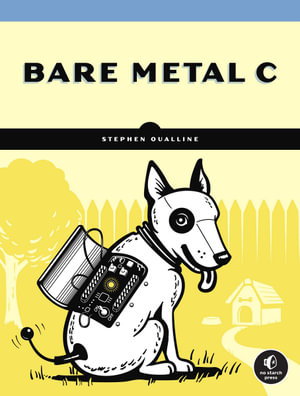| Sun | 12pm – 4pm |
| Mon | 9am – 5:30pm |
| Tue | 9am – 5:30pm |
| Wed | 9am – 5:30pm |
| Thu | 9am – 5:30pm |
| Fri | 9am – 5:30pm |
| Sat | 10am – 5pm |
Ask our staff anything about our shop or products, or share your feedback.

PublishedNo Starch, August 2022 |
ISBN9781718501621 |
FormatSoftcover, 304 pages |
Dimensions23.5cm × 17.8cm |
Bare Metal C will teach you how to program embedded devices with the C programming language. For embedded system programmers who want precise and complete control over the system they are using, this book pulls back the curtain on what the compiler is doing for you so that you can see all the details of what's happening with your program.
The first part of the book teaches C basics with the aid of a low-cost, widely available bare metal system (the Nucleo Arm evaluation system), which gives you all the tools needed to perform basic embedded programming. As you progress through the book you'll learn how to integrate serial input/output (I/O) and interrupts into your programs. You'll also learn what the C compiler and linker do behind the scenes, so that you'll be better able to write more efficient programs that maximize limited memory. Finally, you'll learn how to use more complex, memory hungry C features like dynamic memory, file I/O, and floating-point numbers.
Topic coverage includes-
The basic program creation process
Simple GPIO programming (blink an LED)
Writing serial device drivers
The C linker and preprocessor
Decision and control statements
Numbers, arrays, pointers, strings, and complex data types
Local variables and procedures
Dynamic memory
File and raw I/O
Floating-point numbers
Modular programming
Bare Metal C teaches you to program embedded systems with the C programming language. You'll learn how embedded programs interact with bare hardware directly, go behind the scenes with the compiler and linker, and learn C features that are important for programming regular computers.
Bare Metal C will teach you how to program embedded devices with the C programming language. For embedded system programmers who want precise and complete control over the system they are using, this book pulls back the curtain on what the compiler is doing for you so that you can see all the details of what's happening with your program.
The first part of the book teaches C basics with the aid of a low-cost, widely available bare metal system (the Nucleo Arm evaluation system), which gives you all the tools needed to perform basic embedded programming. As you progress through the book you'll learn how to integrate serial input/output (I/O) and interrupts into your programs. You'll also learn what the C compiler and linker do behind the scenes, so that you'll be better able to write more efficient programs that maximize limited memory. Finally, you'll learn how to use more complex, memory hungry C features like dynamic memory, file I/O, and floating-point numbers.
Topic coverage includes-
The basic program creation process
Simple GPIO programming (blink an LED)
Writing serial device drivers
The C linker and preprocessor
Decision and control statements
Numbers, arrays, pointers, strings, and complex data types
Local variables and procedures
Dynamic memory
File and raw I/O
Floating-point numbers
Modular programming

